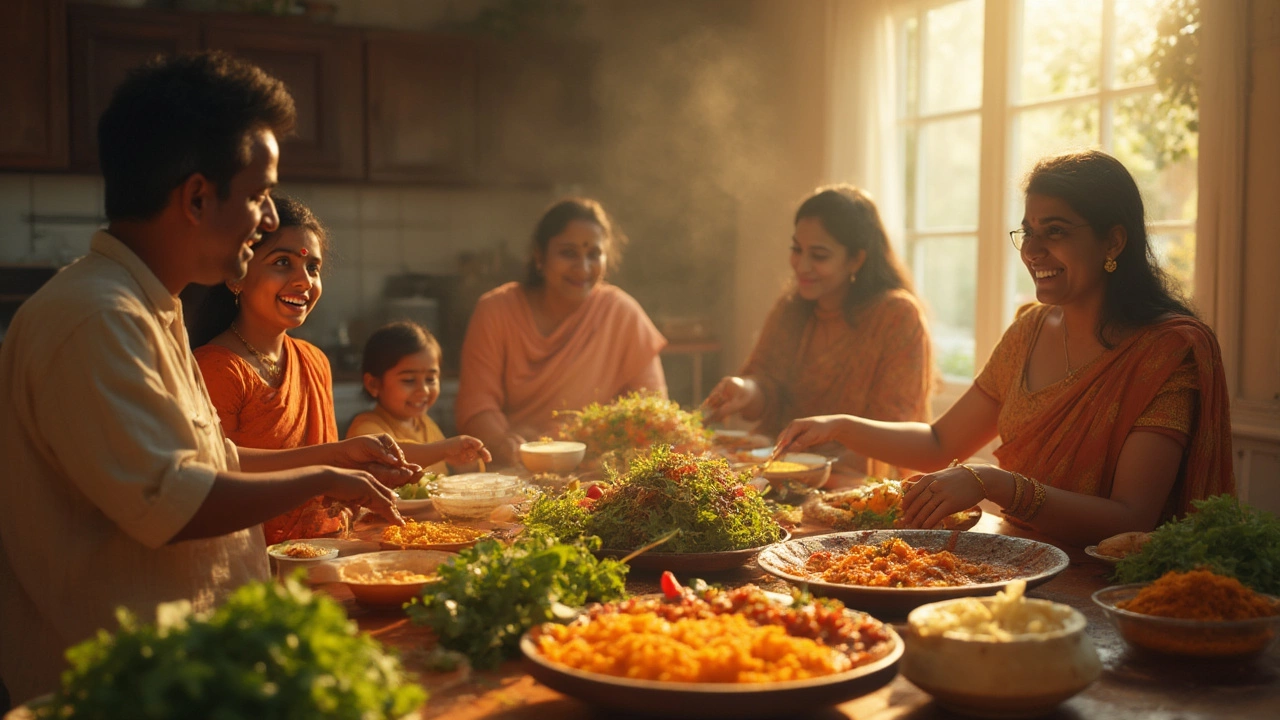Is Indian Food Healthy? Nutrition Facts, Myths, and Expert Tips
 Jul, 23 2025
Jul, 23 2025
Ever wondered how a cuisine bursting with flavors, draped in vibrant colors, and known for big, hearty servings fits into the world of healthy eating? The plate in an Indian household overflows with rotis, curries, dals, rice, chutneys, and something fried or sweet thrown in for good measure. If you've stood in line at an Indian buffet or scrolled through endless reels of butter chicken and biryani, you might question: does delicious have to mean unhealthy? Indian food’s not a one-trick pony; it’s an entire carnival. And if you look beneath the gilded crust of ghee, you'll find a story of ancient grains, fermented foods, piles of vegetables, anti-inflammatory spices, and some clever cooking tricks—if you know what to look for.
Breaking Down the Indian Diet: What's on the Plate?
People sometimes imagine Indian food as either fiery-hot curries or ghee-dripping naan, but that’s just a sliver. Traditional meals look pretty balanced if you peek into Indian kitchens, not just restaurants. Most regions follow a "thali" system: a meal featuring small piles of different things, usually served on one plate. There's a lentil-based dal, a dry veggie stir fry (sabzi), a yogurt dish, a simple flatbread like roti, and a scoop of rice. The South Indian dosa—essentially a fermented crepe made from rice and lentils—packs protein and probiotics without needing an oil bath. The North Indian rajma (kidney bean stew) loaded with onions, tomatoes, and warming spices could outpace plenty of trendy superfood bowls nutritionally.
Packed into every meal, you’ve got layering: protein from dals and beans, carb and fiber from whole grains like brown rice, jowar, bajra, or millets, healthy fats from mustard oil or coconut, and a parade of spices with their own health track records. What you don't see unless you’ve lived in an Indian home is a huge focus on freshness and seasonality. Greens, gourds, squash, carrots, and whatever’s looking good at the street market make it into the day’s sabzi. Plus, yogurt and fermented dishes like idli add good bacteria—way before "gut health" started trending on TikTok.
But why does Indian restaurant food often feel heavier or richer by comparison? Blame it on extra ghee, cream, and bigger doses of salt and sugar, added to attract someone craving a special experience. The classic butter chicken, as made in a Delhi wedding, contains full cream and enough buttery richness to set off any calorie counter. At home, folks tend to cook lighter using less oil, and more veggies and grains. In fact, over 30% of Indians are vegetarian, relying on beans, dals, paneer, or tofu for their protein fix. That sets Indian cuisine apart—most "regular meals" are plant-forward but rarely boring. Add to that things like unrefined cane sugar (jaggery), cold-pressed oils, and unpolished rice, and the basic Indian diet in kitchens across the world already checks off many nutrition goals.
The small portion sizes of each dish also matter. Instead of eating a mound of one food, people nibble a little of everything. This helps balance nutrients and flavors. Indian eating routines also make time for sit-down meals (mindful eating!) and rarely eat on the go. In fact, the use of hands for eating isn’t just culture—it helps slow things down, makes food feel more satisfying, and connects you to your meal.
Good Fats, Super Spices, and Fermented Foods: What Science Says
Modern science finally caught up to grandma’s advice. Turmeric and its main ingredient, curcumin, have gotten shout-outs for their anti-inflammatory powers. Black pepper's piperine helps you absorb more nutrients, especially from turmeric. Cumin boosts digestion. Mustard seeds, curry leaves, fenugreek, coriander, ginger: every spice is there for a reason. These aren’t window-dressing—they push flavor, cut down on oily heaviness, and have the kind of track record that keeps nutritionists nodding their heads.
Healthy fats play a part, too. In South India, many dishes use coconut oil, which contains medium-chain triglycerides thought to boost metabolism and offer quick energy. In the north, mustard oil, with high omega-3s, is the go-to for stir-fries. Ghee is another staple—far from a dietary pariah, a bit of ghee may boost the absorption of vitamins from veggies and also add to gut health, thanks to its short-chain fatty acids. The trick's not drowning food in ghee, but using a teaspoon or two for flavor and texture.
Fermented foods like dosa batter, idli, dhokla, and even homemade pickles (achar) have been around for centuries in Indian kitchens. This means Indian diets include lots of natural probiotics, well before yogurt shots hit shelves. A 2021 paper from the Indian Council of Medical Research found that homemade curd and idli had comparable live bacteria counts to expensive Western "probiotic" products. So, if you're worried about missing out on kefir or kombucha—don’t. Indian cuisine’s got it covered.
Fiber is where Indian food really shines. Most classic recipes use pulses, beans, and legumes, which mean your meal packs both protein and gut-friendly fiber. A serving of rajma (red bean curry) or chana masala delivers fiber that helps with blood sugar control, cholesterol, and keeps you fuller longer. The same applies to humble whole grains—think bajra (pearl millet), jowar (sorghum), and ragi (finger millet). These not only help with digestion but may lower risk of chronic diseases, as shown in recent studies from Indian nutrition institutes.
But watch out: not all versions of Indian food are created equal. Restaurants may boost flavor with extra salt, sugar, or cream to please the average customer. Samosas taste great, but eating three as a meal every day is no health hack. The bottom line: home-style Indian food, cooked with minimal oil, moderate portions, loads of veggies, and traditional spices, is tough to beat from a nutrition standpoint.

Common Myths About Indian Food: Let's Get Real
Indian food is spicy and heavy. Sounds catchy, but it’s not the reality for daily meals. First, Indian food’s heat usually comes from chilies, which you can totally control. Loads of everyday Indian dishes skip chili altogether and focus on depth from ginger, cumin, coriander, or cinnamon. If you’re cooking at home, adjust the spice to fit your taste or gut. Second, about that heaviness—most home cooks don’t use heaps of cream or ghee. A veggie-based curry or dal with roti uses a fraction of the fat found in a restaurant korma.
Ever heard someone complain that Indian food is bad for weight loss? The truth is, most veggies, lentils, and breads (when served in reasonable portions) are low in calories and high in satiety. A big salad, vegetable curry, or dal-rice combo is filling and won't send your blood sugar on a rollercoaster. Weight gain is usually about eating too much, piling on the fried breads (puri, bhatura) and sweets, not the foods themselves. Swap refined white rice for hand-pounded rice, try rotis made with millet or sorghum, or load up on veggies in your sabzi. You’ll stack up nutrition wins pretty fast.
Another myth worth busting: Indian food doesn’t have protein. That’s a head-scratcher, because each serving of dal packs about 8-10 grams of protein per cup, which is higher if you add paneer or tofu. Beans and lentils (rajma, chana, toor dal) combined with rice or roti offer a complete set of amino acids. If you worry about going meatless, just remember: most Indian vegetarian diets include lots of nuts, seeds, and dairy products, making it easy to get enough protein—without a steak in sight.
Some folks worry about carbs, but not all carbs are the same. The ones in whole grains, lentils, and most vegetables break down slowly, providing energy without the crash. It’s the same with ghee—a little boosts taste, but you don’t need to douse your dish. Eating Indian takeout every night? That’s a different story. Counting calories is easy when the food is made at home—much of the perceived "unhealthiness" comes from party foods, not the average Tuesday dinner.
The sodium in restaurant meals can get wild, but home-cooked meals rarely reach those levels. If you cook Indian food at home, choose less salt and ramp up flavor with roasted cumin powder, amchur (dried mango powder), or fresh herbs. One study from the All India Institute of Medical Sciences showed that people eating at home had distinctly lower sodium intakes than those regularly eating street food or takeouts.
There’s even a notion that Indian sweets are always unhealthy. While it's true many desserts use sugar, traditional versions also use jaggery (unrefined cane sugar), nuts, seeds, milk, and sometimes even veggies like carrots (think gajar ka halwa). Eaten in sensible amounts, they’re treats that won’t undo your diet.
How to Eat Indian and Stay Healthy: Practical Tips
If you love Indian food, you don’t have to give it up to stay healthy. Here are a few easy moves:
- Focus on homemade versions whenever possible. You control the salt, oil, and spice.
- Choose whole grains: swap plain white rice for brown rice, millets, or hand-pounded rice.
- Pack in veggies: at least half your plate should be non-starchy vegetables, either stir-fried (sabzi), in sambar, or salads like kachumber.
- Lean on lentils and beans for protein—dals, chana, rajma, and sambar are satisfying and filling.
- Watch portion sizes for high-calorie favorites (naan, paratha, samosa). Enjoy them as a side, not the star.
- Bake or grill where possible over deep frying—think tandoori chicken or roasted gobi over pakoras.
- Use healthy oils mindfully: mustard oil, coconut oil, and ghee in small quantities add depth but don’t overdo it.
- Spice it up: don’t be shy with ginger, cumin, coriander, turmeric, and black pepper—all add flavor and nutrition.
- If cooking with dairy, use low-fat yogurt or light coconut milk for creaminess instead of heavy cream.
- Choose jaggery or dates over refined sugar when making sweets—small changes count.
- Ferment your batters for dosas and idlis to add probiotics to your meals.
There’s another cool trick: meal prepping the Indian way means making a big pot of dal or sabzi you can eat over a few days, changing up your sides to keep things fresh. Add leftover curry to a salad for a midday lunch, or wrap some paneer tikka in a whole-wheat roti with crunchy veggies for a quick, healthy roll.
The bottom line? Modern science and ancient tradition seem to agree: Indian food can be very healthy if you pick the right ingredients and focus on home-style cooking. Each spoonful is a story of balance, not just taste. With a little planning and curiosity, you can enjoy all those big flavors—without the guilt trip. Next time someone asks if Indian food is healthy, just hand them your home-cooked dal and roti—they’ll get the answer with the first bite.
